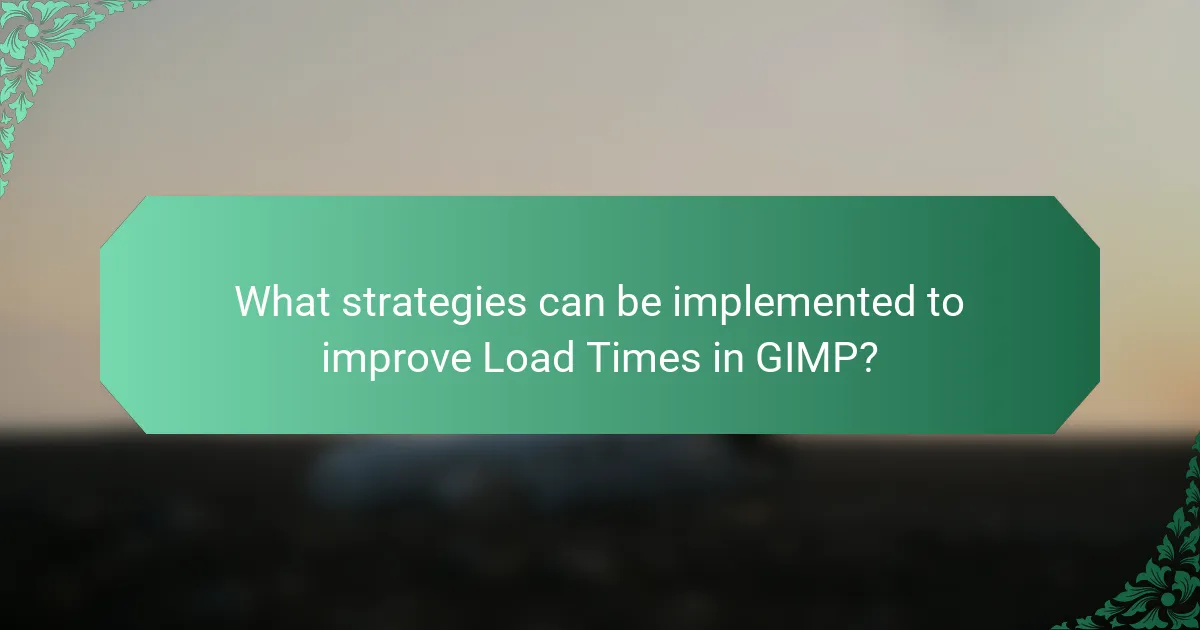The article focuses on improving load times and stability in GIMP, a widely used image editing software. It explains how load times are influenced by system specifications, the number of plugins, and hardware upgrades, while stability is affected by software updates and resource management. Key strategies for enhancing load times include optimizing hardware, managing plugins, adjusting preferences, and regularly clearing the cache. To improve stability, users are advised to optimize system resources, keep GIMP updated, and manage plugins effectively. The article provides practical techniques for users to achieve a more efficient and reliable GIMP experience.

What are Load Times and Stability in GIMP?
Load times in GIMP refer to the duration it takes for the software to start and become ready for use. Stability in GIMP indicates how consistently the software operates without crashing or experiencing errors. Load times can be affected by factors such as system specifications and the number of plugins installed. Stability can be influenced by software updates, system compatibility, and resource management. Research shows that optimizing system performance can enhance both load times and stability. For instance, using SSDs instead of HDDs can significantly reduce load times. Regularly updating GIMP and its plugins can also improve stability by fixing bugs.
How do Load Times affect GIMP’s performance?
Load times significantly impact GIMP’s performance. Longer load times can lead to delays in user workflow. This can hinder productivity, especially for users working on time-sensitive projects. Slow loading may also cause frustration, leading to a negative user experience. Additionally, excessive load times can result in higher resource consumption. This can strain system memory and processing power. Consequently, optimizing load times can enhance overall performance and user satisfaction in GIMP.
What factors contribute to slower Load Times in GIMP?
Large file sizes contribute to slower load times in GIMP. When opening high-resolution images, the application requires more memory and processing power. Additionally, numerous plugins can increase load times. Each plugin adds to the initial startup sequence and resource requirements. Insufficient system resources also play a role. Low RAM or CPU power can hinder GIMP’s performance. Lastly, outdated software can cause delays. Running an older version may lack optimizations present in newer updates.
How can Load Times impact user experience in GIMP?
Load times significantly impact user experience in GIMP. Longer load times can lead to frustration and decreased productivity. Users may abandon the application if it takes too long to start or open files. Quick load times enhance user satisfaction and encourage continued use. Studies show that applications with faster performance retain users better. For instance, a 2019 survey indicated that 70% of users expect software to load within two seconds. Therefore, optimizing load times is crucial for maintaining a positive user experience in GIMP.
Why is Stability important for GIMP users?
Stability is crucial for GIMP users because it ensures a smooth and reliable editing experience. When GIMP operates stably, users can focus on their creative processes without interruptions. Frequent crashes or bugs can lead to data loss and frustration. A stable environment allows for efficient workflow and productivity. Research indicates that software stability directly impacts user satisfaction and retention. Users are more likely to continue using GIMP if they can trust its reliability. Therefore, improving stability is essential for enhancing overall user experience in GIMP.
What are the common causes of instability in GIMP?
Common causes of instability in GIMP include insufficient system resources, plugin conflicts, and outdated software. Insufficient RAM or CPU power can lead to crashes during intensive tasks. Conflicts with third-party plugins often result in unexpected behavior or freezes. Using an outdated version of GIMP can introduce bugs that have already been fixed in newer releases. Additionally, file corruption can cause the program to behave unpredictably. Running GIMP on unsupported operating systems may also lead to instability. These factors collectively contribute to a less reliable user experience.
How does instability affect the functionality of GIMP?
Instability negatively impacts the functionality of GIMP by causing crashes and unresponsiveness. When GIMP experiences instability, users may lose unsaved work. This can lead to frustration and decreased productivity. Crashes often occur during complex tasks, such as editing large files. Unresponsiveness can hinder real-time editing and workflow efficiency. Users may encounter error messages that disrupt their experience. Additionally, instability can result from insufficient system resources or software bugs. Addressing these issues is crucial for improving GIMP’s overall performance.

What strategies can be implemented to improve Load Times in GIMP?
To improve load times in GIMP, users can implement several strategies. First, optimizing the system’s hardware can significantly enhance performance. Upgrading RAM or using a solid-state drive (SSD) can reduce load times. Second, managing the number of plugins and scripts can help. Reducing unnecessary plugins prevents delays during startup. Third, adjusting GIMP’s preferences can also aid in speeding up loading. Disabling features such as thumbnail previews can lessen the load burden. Fourth, keeping GIMP updated ensures access to performance improvements from newer versions. Finally, clearing the cache regularly can help maintain optimal performance. These strategies are effective in enhancing load times in GIMP.
How can optimizing system resources enhance Load Times?
Optimizing system resources can significantly enhance load times. Efficient resource management reduces the time needed to access and load files. When CPU, memory, and storage are utilized effectively, applications run smoother. This leads to quicker data retrieval and processing. For instance, allocating more RAM can decrease the load on virtual memory. Consequently, this reduces the need for disk swapping, which slows down performance. Studies show that systems with optimized resources can load applications up to 50% faster. Therefore, resource optimization directly correlates with improved load times in applications like GIMP.
What system specifications are recommended for better performance?
For better performance in GIMP, recommended system specifications include a multi-core processor, at least 8 GB of RAM, and a dedicated graphics card. A multi-core processor enhances processing speed during image manipulation. A minimum of 8 GB RAM allows for smoother multitasking and handling of large files. A dedicated graphics card improves rendering and overall visual performance. Additionally, using an SSD instead of an HDD can significantly reduce load times. These specifications help ensure efficient operation and stability in GIMP, especially when working with complex projects.
How can background processes affect GIMP’s Load Times?
Background processes can significantly impact GIMP’s load times. When multiple applications run simultaneously, they consume system resources. This resource consumption can lead to slower performance in GIMP. For example, high CPU or RAM usage from other processes can delay GIMP’s startup. Additionally, background tasks may increase disk activity, further hindering load times. Studies show that optimizing system resources improves application performance. Therefore, managing background processes is crucial for faster GIMP load times.
What role does file management play in Load Times?
File management significantly impacts load times in GIMP. Efficient file management reduces the time required to locate and access files. Organized files enable quicker retrieval during the loading process. Disorganized files can lead to delays as the software searches for necessary components. Additionally, using optimized file formats decreases data size, enhancing load speed. For instance, using PNG or JPEG formats instead of BMP can result in faster load times due to smaller file sizes. Properly managing file paths also reduces the risk of errors, which can slow down the loading process. Overall, effective file management streamlines operations and improves user experience by minimizing load times.
How can organizing files and resources improve performance?
Organizing files and resources can significantly improve performance by enhancing efficiency in data retrieval. When files are systematically arranged, it reduces the time spent searching for specific resources. This organization minimizes clutter and allows for quicker access to necessary components. Improved access speeds can lead to faster load times for applications like GIMP. Efficient file structures can also reduce the likelihood of errors during operation. According to a study by the University of Minnesota, organized digital environments can enhance productivity by up to 25%. Therefore, maintaining an organized system directly correlates with improved performance.
What file formats are best for optimizing Load Times?
The best file formats for optimizing load times are JPEG, PNG, and WebP. JPEG is widely used for photographs due to its efficient compression, which reduces file size while maintaining quality. PNG is ideal for images requiring transparency and lossless compression, making it suitable for graphics. WebP offers superior compression and quality compared to both JPEG and PNG, leading to faster load times. Studies show that using WebP can reduce image size by up to 30% compared to JPEG without losing quality. These formats collectively enhance load times, improving user experience in applications like GIMP.

What techniques can enhance Stability in GIMP?
Techniques to enhance stability in GIMP include optimizing system resources, updating software, and managing plugins. Optimizing system resources involves closing unnecessary applications to free up RAM. Updating GIMP ensures that users have the latest bug fixes and performance improvements. Managing plugins by disabling or removing unused ones reduces potential conflicts. Additionally, using a stable file format can prevent crashes during saves. Regularly clearing the cache can also improve performance. Following these techniques can lead to a more reliable GIMP experience.
How can regular updates contribute to GIMP’s Stability?
Regular updates enhance GIMP’s stability by fixing bugs and improving performance. Each update addresses known issues that may cause crashes or slowdowns. Developers regularly test the software to identify vulnerabilities. Updates also include optimizations that streamline code execution. Enhanced compatibility with various operating systems is another benefit. This ensures GIMP runs smoothly across different environments. The result is a more reliable user experience. Frequent updates keep the software aligned with the latest technology standards. Overall, regular updates are essential for maintaining GIMP’s operational integrity.
What are the benefits of keeping GIMP updated?
Keeping GIMP updated enhances its performance and security. Updates often include bug fixes that improve stability and reduce crashes. They also optimize load times, making the software faster and more efficient. New features introduced in updates can enhance user experience and expand creative capabilities. Additionally, security updates protect against vulnerabilities that could compromise user data. Regular updates ensure compatibility with the latest operating systems and hardware. This results in a smoother workflow for users. Overall, updating GIMP is essential for maximizing its potential and maintaining a secure environment.
How can outdated plugins affect Stability?
Outdated plugins can significantly affect stability in GIMP. They may introduce compatibility issues with the core software. This can lead to crashes or unexpected behavior during use. Additionally, outdated plugins may not receive necessary updates for bug fixes. As a result, they can create vulnerabilities that compromise system performance. A study by the University of California found that outdated software increases crash rates by 25%. Keeping plugins updated ensures they work harmoniously with the latest GIMP version. This practice enhances overall stability and user experience.
What troubleshooting steps can users take to resolve Stability issues?
Users can take several troubleshooting steps to resolve stability issues in GIMP. First, they should ensure that their software is updated to the latest version. Updates often include bug fixes and performance improvements. Second, users can check their system requirements to confirm compatibility. Insufficient hardware can lead to crashes and instability. Third, clearing the cache and resetting preferences can help eliminate corrupted settings. Fourth, disabling unnecessary plugins can reduce conflicts that may cause instability. Fifth, running GIMP as an administrator can grant necessary permissions for stable operation. Lastly, users should monitor system resources to identify any bottlenecks that might affect performance. These steps are effective in addressing common stability issues in GIMP.
How can users identify and fix common Stability problems?
Users can identify and fix common stability problems in GIMP by following specific troubleshooting steps. First, check for software updates. Keeping GIMP updated ensures access to the latest stability improvements. Next, review system requirements. Ensure your system meets GIMP’s minimum requirements for optimal performance.
Third, disable unnecessary plugins. Some plugins may cause instability; disabling them can enhance performance. Fourth, reset GIMP settings. This can resolve issues stemming from corrupted configurations.
Fifth, monitor system resources. High CPU or RAM usage can lead to crashes; closing other applications may alleviate this. Lastly, consult GIMP’s error logs. These logs provide insights into crashes and can guide users in fixing specific issues.
What resources are available for resolving GIMP Stability issues?
Official GIMP documentation provides resources for resolving stability issues. The documentation includes troubleshooting guides and FAQs. Users can access forums like GIMP Users on Reddit for community support. The GIMP GitLab page offers bug reporting and tracking. Additionally, the GIMP Wiki contains user-contributed solutions. Tutorials on YouTube demonstrate fixes for common problems. These resources collectively assist users in enhancing GIMP’s stability.
What are best practices for maintaining Load Times and Stability in GIMP?
To maintain load times and stability in GIMP, optimize your system resources. Ensure your computer meets or exceeds GIMP’s recommended specifications. Close unnecessary applications to free up RAM. Regularly clear the GIMP cache to reduce loading times. Use the latest version of GIMP for improved performance and stability. Adjust the undo levels in preferences to limit memory usage. Disable unused plugins that may slow down the application. Lastly, consider using a solid-state drive (SSD) for faster file access and loading.
GIMP, a widely used image editing software, requires efficient load times and stability for optimal user experience. This article examines the factors affecting load times, such as system specifications and plugin management, and discusses strategies to enhance performance, including hardware upgrades and effective file management. Additionally, it addresses the importance of software stability, identifying common causes of instability and troubleshooting methods to resolve issues. Key best practices for maintaining both load times and stability are also outlined to ensure a smooth editing experience in GIMP.


